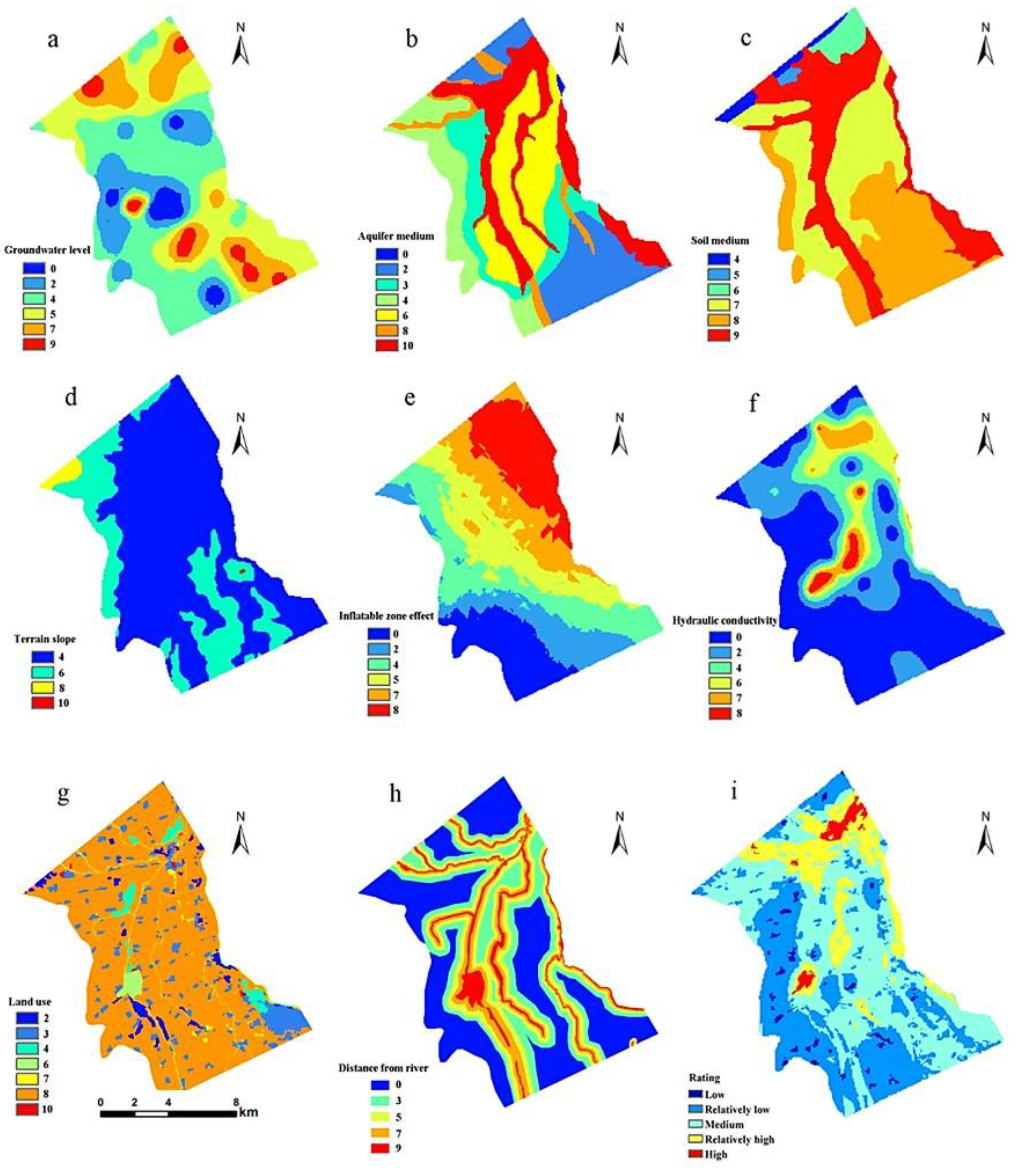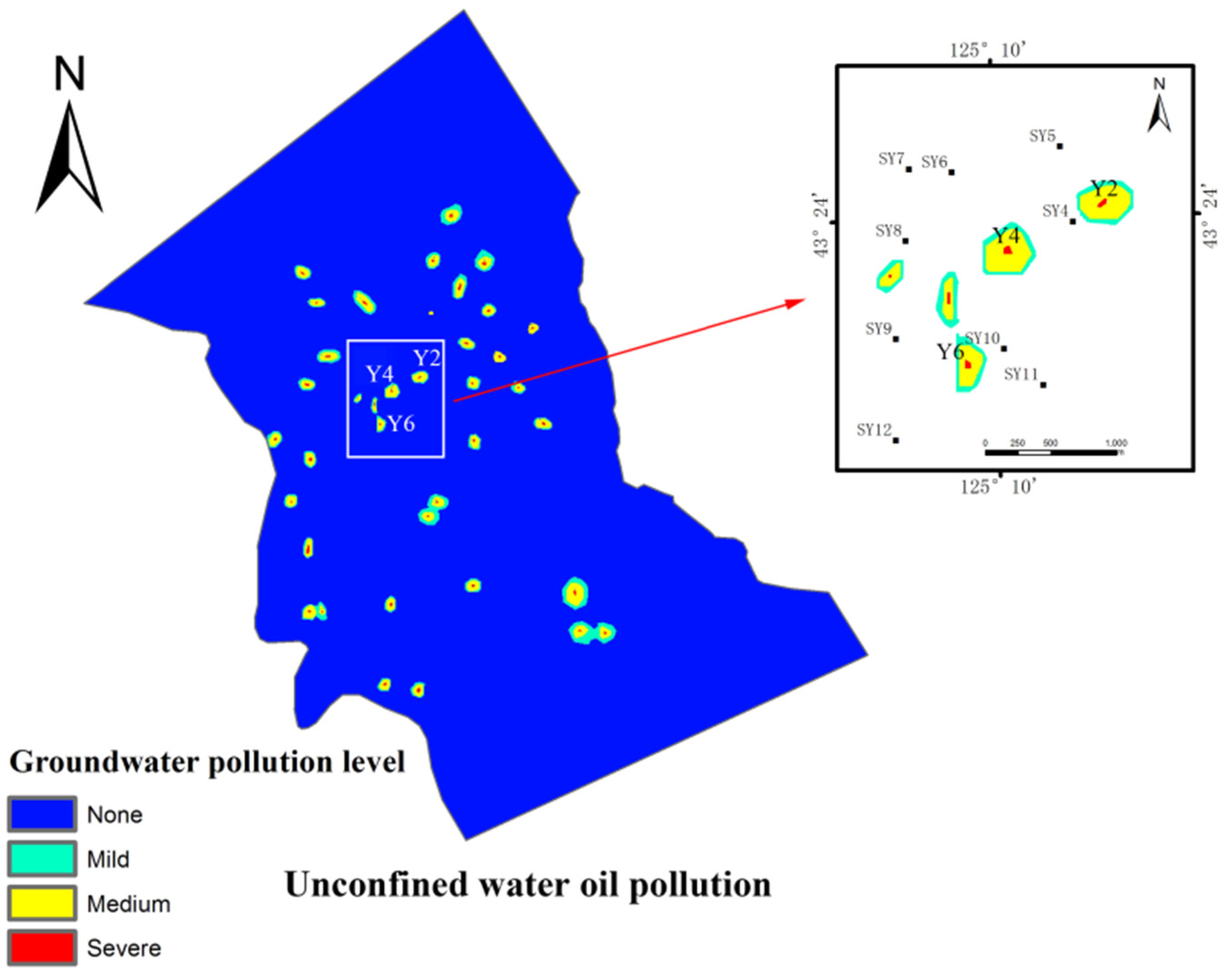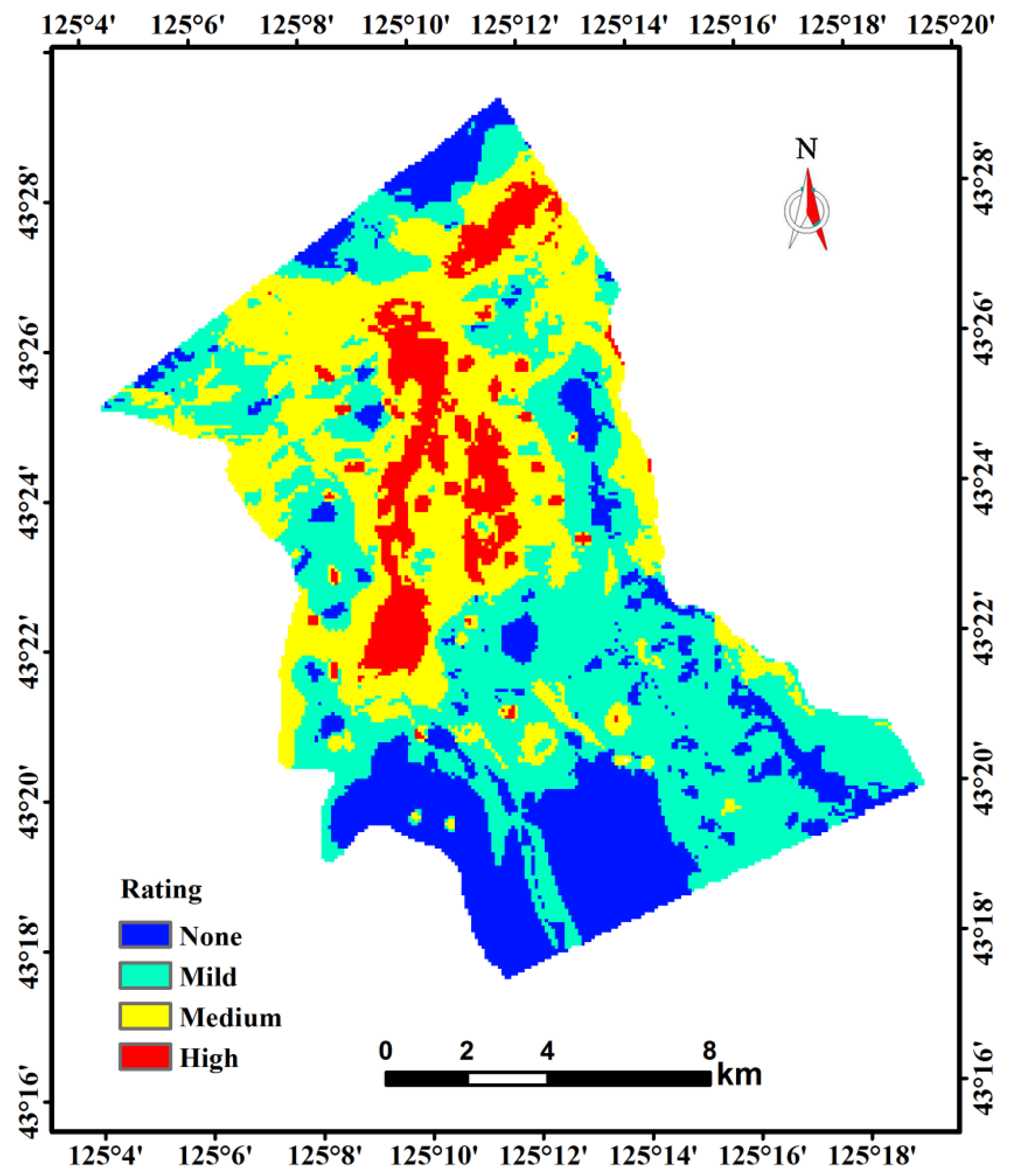Assessment of Groundwater Contamination Risk in Oilfield Drilling Sites Based on Groundwater Vulnerability, Pollution Source Hazard, and Groundwater Value Function in Yitong County
Abstract
:1. Introduction
2. Study Area
3. Materials and Methods
3.1. Groundwater Vulnerability Assessment
3.2. Groundwater Pollution Source Hazard Evaluation
3.3. Groundwater Function Assessment
3.4. Comprehensive Assessment of Groundwater Pollution Risk
4. Results and Discussion
4.1. Groundwater Vulnerability Assessment
4.2. Groundwater Pollution Source Hazard Evaluation
4.3. Groundwater Function Value Assessment
4.4. Comprehensive Assessment of Groundwater Pollution Risk
5. Conclusions
Author Contributions
Funding
Institutional Review Board Statement
Informed Consent Statement
Data Availability Statement
Acknowledgments
Conflicts of Interest
References
- Wang, W.; Chen, D.; Ma, Z.; Chen, P. Forecast and suitability assessment of monitored natural attenuation (MNA) of petroleum pollutant in shallow groundwater. Water Sav. Irrig. 2014, 8, 29–33. [Google Scholar]
- Miao, Y. The way, harm and preventive measures of groundwater pollution caused by oil exploitation. Water Resour. Dev. Res. 2016, 5, 32–33. [Google Scholar]
- Chang, K. The Effect of Iron Catalyst on Oxidation of Oil Contaminated Soil. Master’s Thesis, Xi’an University of Architecture and Technology, Xi’an, China, 2013. [Google Scholar]
- An, Y. Study on Risk Assessment and Early Warning of Groundwater Pollution in the Ordos Basin. Master’s Thesis, Jilin University, Changchun, China, 2016. [Google Scholar]
- Sun, X. A brief analysis of the management and protection of groundwater resources. Priv. Technol. 2014, 8, 248. [Google Scholar]
- Kaliraj, S.; Chandrasekar, N.; Peter, T.S.; Selvakumar, S.; Magesh, N.S. Mapping of coastal aquifer vulnerable zone in the south west coast of Kanyakumari, South India, using GIS-based DRASTIC model. Environ. Monit. Assess. 2015, 187, 4073. [Google Scholar] [CrossRef] [PubMed]
- Khan, R.; Jhariya, D.C. Assessment of Groundwater Pollution Vulnerability Using GIS Based Modified DRASTIC Model in Raipur City, Chhattisgarh. J. Geol. Soc. India 2019, 93, 293–304. [Google Scholar] [CrossRef]
- Medici, G.; Engdahl, N.B.; Langman, J.B. A Basin-Scale Groundwater Flow Model of the Columbia Plateau Regional Aquifer System in the Palouse (USA): Insights for Aquifer Vulnerability Assessment. Int. J. Environ. Res. 2021, 15, 299–312. [Google Scholar] [CrossRef]
- Wang, L.; Liu, T.; Hao, W.; Song, Y.; Liu, Y. Comparison of groundwater vulnerability assessment methods. Inn. Mong. Water Resour. 2019, 7, 15–17. [Google Scholar]
- Ouedraogo, I.; Girard, A.; Vanclooster, M.; Jonard, F. Modelling the Temporal Dynamics of Groundwater Pollution Risks on the African Scale. Water 2020, 12, 1406. [Google Scholar] [CrossRef]
- National Research Council. Groundwater Vulnerability Assessment, Contaminant Potential under Conditions of Uncertainity; National Academy Press: Washington, DC, USA, 1993. [Google Scholar]
- Tesoriero, A.J.; Inkpen, E.L.; Voss, F.D. Assessing groundwater vulnerability using logistic regression. In Proceedings of the Source Water Assessment and Protection 98 Conference, Dallas, TX, USA, 28–30 April 1998; pp. 157–165. [Google Scholar]
- Harbaugh, A.W.; Banta, E.R.; Hill, M.C.; Mcdonald, M.G. MODFLOW-2000, The US Geological Survey Modular Ground-Water Model-Users Guide to Modularization Concepts and the Groundwater Flow Process; US Geological Survey Open—File Report 00-92; US Geological Survey: Reston, VA, USA, 2000; p. 121.
- Dixon, B. Prediction of groundwater vulnerability using an integrated GIS-based neuro-fuzzy techniques. J. Hydrol. 2004, 4, 17–38. [Google Scholar]
- Neshat, A.; Pradhan, B.; Pirasteh, S.; Shafri, H.Z.M. Estimating groundwater vulnerability to pollution using a modified DRASTIC model in the Kerman agricultural area, Iran. Environ. Earth Sci. 2014, 71, 3119–3131. [Google Scholar] [CrossRef]
- Sinha, M.K.; Verma, M.K.; Ahmad, I.; Baier, K.; Jha, R.; Azzam, R. Assessment of groundwater vulnerability using modified DRASTIC model in Kharun Basin, Chhattisgarh, India. Arab. J. Geosci. 2015, 9, 98. [Google Scholar] [CrossRef]
- Noori, R.; Ghahremanzadeh, H.; Kløve, B.; Adamowski, J.; Baghvand, A. Modified-DRASTIC, modified-SINTACS and SI methods for groundwater vulnerability assessment in the southern Tehran aquifer. J. Environ. Sci. Health 2019, 54, 89–100. [Google Scholar] [CrossRef] [PubMed]
- Evans, B.M.; Mayers, W.L. A GIS-based approach to evaluating regional groundwater pollution potential with DRASTIC. J. Soil Water Conserv. 1990, 45, 242–245. [Google Scholar]
- Fritch, T.G.; McKnight, C.L.; Yelderman, J.J.C.; Arnold, J.G. An aquifer vulnerability assessment of the paluxy aquifer, central Texas, USA, using GIS and a modified DRASTIC approach. Environ. Manag. 2000, 25, 337–345. [Google Scholar] [CrossRef] [PubMed]
- Knox, R.C.; Sabatini, D.A.; Canter, L.W. Subsurface Transport and Fate Processes; Lewis Publishers: Boca Raton, FL, USA, 1993. [Google Scholar]
- Secunda, S.; Collin, M.; Melloul, A.J. Groundwater vulnerability assessment using a composite model combining DRASTIC with extensive land use in Israel’s Sharon region. J. Environ. Manag. 1998, 54, 39–57. [Google Scholar] [CrossRef]
- Aller, I.; Bennet, T.; Lehr, J.H.; Petty, R.J. A Standardized System for Evaluating Groundwater Pollution Potential Using Hydrogeologic Settings; U.S. EPA Report; U.S. Environmental Protection Agency: Washington, DC, USA, 1987.
- Nawafleh, A.S.M. GIS-Based Modeling of Groundwater Vulnerability and Hydrochemistry in Irbid Governorate. Ph.D. Thesis, University of Jordan, Amman, Jordan, 2007. [Google Scholar]
- Ewa, K.; Sebastian, Z.; Danuta, Z. Variability of Intrinsic Groundwater Vulnerability to Pollution in River Valley due to Groundwater Depth and Recharge Changes. Appl. Sci. 2019, 9, 1133. [Google Scholar]
- Vrba, J.; Zaporozec, A. Guidebook on Mapping Groundwater Vulnerability; International Contributions to Hydrogeology; H. Heise: Hanover, Germany, 1994. [Google Scholar]
- Ducci, D.; De, M.G.; Delli, P.G. Contamination risk of the Alburni Karst System (Southern Italy). Eng. Geol. 2008, 99, 109–120. [Google Scholar] [CrossRef]
- Yao, W. Study on Groundwater Vulnerability Based on Process Simulation. Ph.D. Thesis, Tsinghua University, Beijing, China, 2007. [Google Scholar]
- Li, H.; Yu, X.; Zhang, W.; Huan, Y.; Yu, J.; Zhang, Y. Risk Assessment of Groundwater Organic Pollution Using Hazard, Intrinsic Vulnerability, and Groundwater Value, Suzhou City in China. Expo. Health 2018, 10, 99–115. [Google Scholar] [CrossRef]
- Li, R.; Merchant, J.W. Modeling vulnerability of groundwater to pollution under future scenarios of climate change and biofuels-related land use change: A case study in North Dakota, USA. Total Environ. 2013, 447, 32–45. [Google Scholar] [CrossRef] [Green Version]
- Xue, Y.; Liu, R.; Xu, S. Groundwater Vulnerability Assessment and Analysis Based on LM-BP Neural Network. New Technol. New Prod. China 2016, 9, 125–126. [Google Scholar]
- Soraya, K.; Nozar, S.; Zargham, M. Characterization of Semnan thermal springs using principal component analysis and geochemical inverse modeling. Arab. J. Geosci. 2019, 12, 777. [Google Scholar]
- Nixdorf, E.; Sun, Y.; Lin, M.; Kolditz, O. Development and application of a novel method for regional assessment of groundwater contamination risk in the Songhua River Basin. Total Environ. 2017, 605, 598–609. [Google Scholar] [CrossRef] [PubMed]
- Baalousha, H.M. Vulnerability, probability and groundwater contamination risk. Environ. Earth Sci. 2017, 76, 383–384. [Google Scholar] [CrossRef]
- Khaiwal, R.; Parteek, S.; Sahil, M.; Tanbir, S.; Suman, M. Evaluation of groundwater contamination in Chandigarh: Source identification and health risk assessment. Environ. Pollut. 2019, 255, 113062. [Google Scholar]
- Huan, H.; Zhang, B.; Kong, H.; Li, M.; Wang, W.; Xi, B.; Wang, G. Comprehensive assessment of groundwater pollution risk based on HVF model: A case study in Jilin City of northeast China. Total Environ. 2018, 628–629, 1518–1530. [Google Scholar] [CrossRef]
- Kumar, S.; Thirumalaivasan, D.; Radhakrishnan, N. GIS Based Assessment of Groundwater Vulnerability Using Drastic Model. Arab. J. Sci. Eng. 2014, 39, 207–216. [Google Scholar] [CrossRef]
- Amharref, M.; Bouchnan, R.; Bernoussi, A.S. Extension of DRASTIC Approach for Dynamic Vulnerability Assessment in Fissured Area: Application to the Angad Aquifer (Morocco); Springer: Berlin/Heidelberg, Germany, 2015. [Google Scholar]
- Sun, C.; Chen, X.T.; Chen, X.J.; Zheng, D. Recent advances in groundwater contamination risk assessment. Adv. Sci. Technol. Water Resour. 2015, 35, 152–161. [Google Scholar]
- Wang, J.; He, J.; Chen, H. Assessment of groundwater contamination risk using hazard quantification, a modified DRASTIC model and groundwater value, Beijing Plain, China. Total Environ. 2012, 432, 216–226. [Google Scholar] [CrossRef]
- National Research Council. Valuing Ground Water: Economic Concepts and Approaches, 1st ed.; National Academies Press: Washington, DC, USA, 1997. [Google Scholar]
- Li, J. Development and Application of Petroleum Contaminated Groundwater Management Models with Consideration of Health Risk. Ph.D. Thesis, North China Electric Power University, Beijing, China, 2016. [Google Scholar]
- Zhang, L. Review on groundwater vulnerability and risk assessment. Hydrogeol. Eng. Geol. 2006, 6, 113–119. [Google Scholar]
- Jiang, J.; Dong, D.; Yang, G.; Wang, L. Risk assessment of groundwater pollution of Haidian District of Beijing. Urban Geol. 2010, 5, 14–18. [Google Scholar]
- Liu, H.; Zhang, B.; Fan, M.; Shi, Y.; Yang, X.; Zhang, J.; Liu, D. Karst Groundwater Value Evaluation of Feicheng Basin. Yellow River 2014, 36, 74–76. [Google Scholar]
- Hua, S. Optimal Management and Protective Measures of Groundwater Resources in China Based on Vulnerability Assessment under the Changing Environment. Master’s Thesis, Hunan University, Changsha, China, 2016. [Google Scholar]
- Lv, D.; Liu, R.; Lian, X.; Zhu, J.; Lin, B.; Chen, J. Characteristics of lithologic hydrocarbon reservoir in the second member of Shuangyang Formation in Moliqing fault depression of Yitong Basin. Glob. Geol. 2016, 35, 470–479. [Google Scholar]
- Liu, C.S.; Li, L.J. Groundwater Evaluation in Quasi Protected Areas of Drinking Water Sources in Yitong Area; Geological Environment Monitoring Station: Changchun, China, 2016.
- Abu-Bakr, H.A.-A. Groundwater vulnerability assessment in different types of aquifers. Agric. Water Manag. 2020, 240, 106275. [Google Scholar] [CrossRef]
- Chen, Q.; Zhao, Z.; Jiang, Q.; Zhou, J.-X.; Tian, Y.; Zeng, S.; Wang, J. Detecting subtle alteration information from ASTER data using a multifractal-based method: A case study from Wuliang Mountain, SW China. Ore Geol. Rev. 2019, 115, 103182. [Google Scholar] [CrossRef]
- Zhong, X.; Ma, T.; Liu, L.; Dong, Y.; Wang, Y.; Zhang, J. Method Research on the Risk Level Evaluation of Contamination Sources for Drinking Groundwater Wellhead. Saf. Environ. Eng. 2014, 21, 104–108. [Google Scholar]
- Chen, H.; Li, Y. Simulation on in-situ air sparging remediation of BTEX-contaminated groundwater. China Environ. Sci. 2014, 30, 46–51. [Google Scholar]
- Liu, J. Application of GMS software in the determination of anti-floating water level of underground rail transit project. Groundwater 2017, 39, 22–23. [Google Scholar]
- Fang, Z. Research of Groundwater Vulnerability in Songnen Plain. Master’s Thesis, Jilin University, Changchun, China, 2007. [Google Scholar]
- Qi, Q.Q.; Xu, Y.X.; Song, S.H.; Zhang, Z.Z. Application of a groundwater modelling system in groundwater environmental impact assessment of river and lake connection in western Jilin region. Appl. Ecol. Environ. Res. 2019, 17, 5059–5066. [Google Scholar] [CrossRef]
- Feng, Z.Y.; Zhang, H.; Dong, S.G. Numerical simulation of landfill leachate underground migration and sensitivity analysis of model parameters. J. Yangtze River Sci. Res. Inst. 2011, 28, 107–111. [Google Scholar]
- Noori, R.; Hooshyaripor, F.; Javadi, S.; Dodangeh, M.; Tian, F.Q.; Adamowski, J.F.; Berndtsson, R.; Baghvand, A.; Klove, B. PODMT3DMS-Tool: Proper orthogonal decomposition linked to the MT3DMS model for nitrate simulation in aquifers. Hydrogeol. J. 2020, 28, 1125–1142. [Google Scholar] [CrossRef]
- Zhao, Y.S.; Zhang, J.W.; Chen, Z.; Zhang, W.H. Groundwater contamination risk assessment based on intrinsic vulnerability, pollution source assessment, and groundwater function zoning. Hum. Ecol. Risk Assess. 2019, 25, 1907–1923. [Google Scholar] [CrossRef]
- China Geological Survey. Technical Requirements for Groundwater Vulnerability Assessment; China Geological Survey: Beijing, China, 2006.
- Guo, J.; Zhao, L.; Liu, N. Study on the ability of blocking pollutants in the vadose zone based on DRASTIC. Environ. Pollut. Prev. 2011, 33, 52–55. [Google Scholar]
- Duda, R.; Klebert, I.; Zdechlik, R. Groundwater Pollution Risk Assessment Based on Vulnerability to Pollution and Potential Impact of Land Use Forms. Pol. J. Environ. Stud. 2020, 29, 87–99. [Google Scholar] [CrossRef]







| Rating | Depth to Water (m) | Aquifer Media | Soil Medium | Terrain Slope (%) | Impact of the Vadose Zone | Hydraulic Conductivity (m/d) | Land Use Types | Distance to Rivers (m) |
|---|---|---|---|---|---|---|---|---|
| 10 | 0–1.0 | Fan-shaped sandy gravel | Rubbish | 0–0.01 | Gravel | ≥100 | Industrial land | - |
| 9 | 1.0–3.0 | Ice water sedimentation with kaolin soil gravel | Sand gravel | 0.01–0.05 | Sand gravel | - | - | 0–100 |
| 8 | - | River valley plain gravel | - | 0.05–0.10 | Coarse sand | 80–100 | Dry land | - |
| 7 | 3.0–5.0 | Ice water stacked gravel | Loess, Sand loam | - | Fine sand | - | - | 100–300 |
| 6 | - | Wavy platform gravel | Fine sand | 0.10~0.30 | Silty sand | 50–80 | Surface waters | - |
| 5 | 5.0–10 | Waxy platform sand, fine sand | Silty sand | - | Sub-sand | - | - | 300–500 |
| 4 | - | Sandstone | Sub-clay | - | Muddy sub-sand | 30–50 | Paddy field | - |
| 3 | 10.0–15 | Medium coarse sandstone | - | 0.30–0.50 | Sub-clay | 20–30 | Residential land | 500–800 |
| 2 | 15–20 | Gravel fine sandstone | Muddy clay | 0.50–0.80 | - | 4–20 | Woodland | - |
| 1 | ≥20 | Bedrock | Silt | ≥0.80 | Bedrock | <4 | - | ≥800 |
| Grade | Low | Relatively Low | Medium | Relatively High | High |
|---|---|---|---|---|---|
| Range | 2.5–3.0 | 3.0–3.5 | 3.5–4.0 | 4.0–4.5 | 4.5–5.5 |
| Assessment Indicator | Weight Coefficient | Weight Value |
|---|---|---|
| D | 0.443 | 0.17 |
| A | 0.206 | 0.079 |
| S | 0.229 | 0.088 |
| T | 0.242 | 0.093 |
| I | 0.451 | 0.173 |
| C | 0.412 | 0.158 |
| L | 0.242 | 0.093 |
| DR | 0.381 | 0.146 |
| Sources-Sinks | Calculated Value | Total | Parameter | Calculated Value |
|---|---|---|---|---|
| Area (km2) | - | 197.51 | Area (km2) | 197.51 |
| Precipitation infiltration | 11.38~373.07 | 1014.61 | Hydraulic conductivity (m/d) | 4~102 |
| Lateral inflow | 0~187.08 | 196.16 | Specific yield | 0.03~0.25 |
| River infiltration | 0~61.40 | 157.42 | Irrigation leakage coefficient | 0.05~0.15 |
| Irrigation flow | 0.80~12.88 | 71.1 | Evaporation coefficient | 0~0.1 |
| Evaporation | 0~−228.98 | −340.81 | Longitudinal diffusion coefficient (m2/h) | 3.98 |
| Lateral outflow | 0~−63.40 | −63.4 | Lateral diffusion coefficient (m2/h) | 0.313 |
| Artificial mining | −9.13~−302.61 | −971.87 |
Publisher’s Note: MDPI stays neutral with regard to jurisdictional claims in published maps and institutional affiliations. |
© 2022 by the authors. Licensee MDPI, Basel, Switzerland. This article is an open access article distributed under the terms and conditions of the Creative Commons Attribution (CC BY) license (https://creativecommons.org/licenses/by/4.0/).
Share and Cite
Fang, Z.; Liu, Z.; Zhao, S.; Ma, Y.; Li, X.; Gao, H. Assessment of Groundwater Contamination Risk in Oilfield Drilling Sites Based on Groundwater Vulnerability, Pollution Source Hazard, and Groundwater Value Function in Yitong County. Water 2022, 14, 628. https://doi.org/10.3390/w14040628
Fang Z, Liu Z, Zhao S, Ma Y, Li X, Gao H. Assessment of Groundwater Contamination Risk in Oilfield Drilling Sites Based on Groundwater Vulnerability, Pollution Source Hazard, and Groundwater Value Function in Yitong County. Water. 2022; 14(4):628. https://doi.org/10.3390/w14040628
Chicago/Turabian StyleFang, Zhang, Zhiguo Liu, Siyuan Zhao, Yanlin Ma, Xia Li, and Han Gao. 2022. "Assessment of Groundwater Contamination Risk in Oilfield Drilling Sites Based on Groundwater Vulnerability, Pollution Source Hazard, and Groundwater Value Function in Yitong County" Water 14, no. 4: 628. https://doi.org/10.3390/w14040628
APA StyleFang, Z., Liu, Z., Zhao, S., Ma, Y., Li, X., & Gao, H. (2022). Assessment of Groundwater Contamination Risk in Oilfield Drilling Sites Based on Groundwater Vulnerability, Pollution Source Hazard, and Groundwater Value Function in Yitong County. Water, 14(4), 628. https://doi.org/10.3390/w14040628






